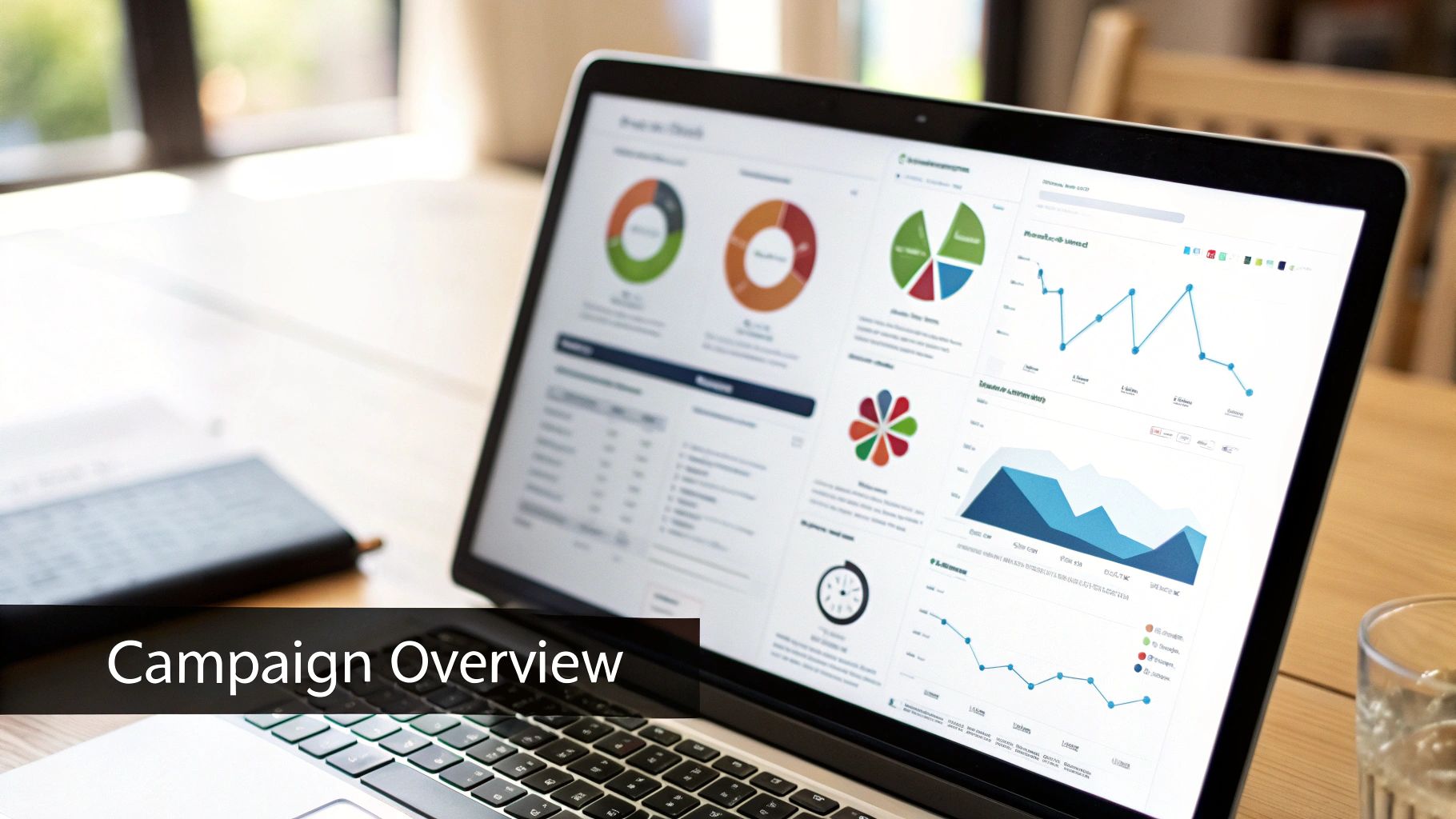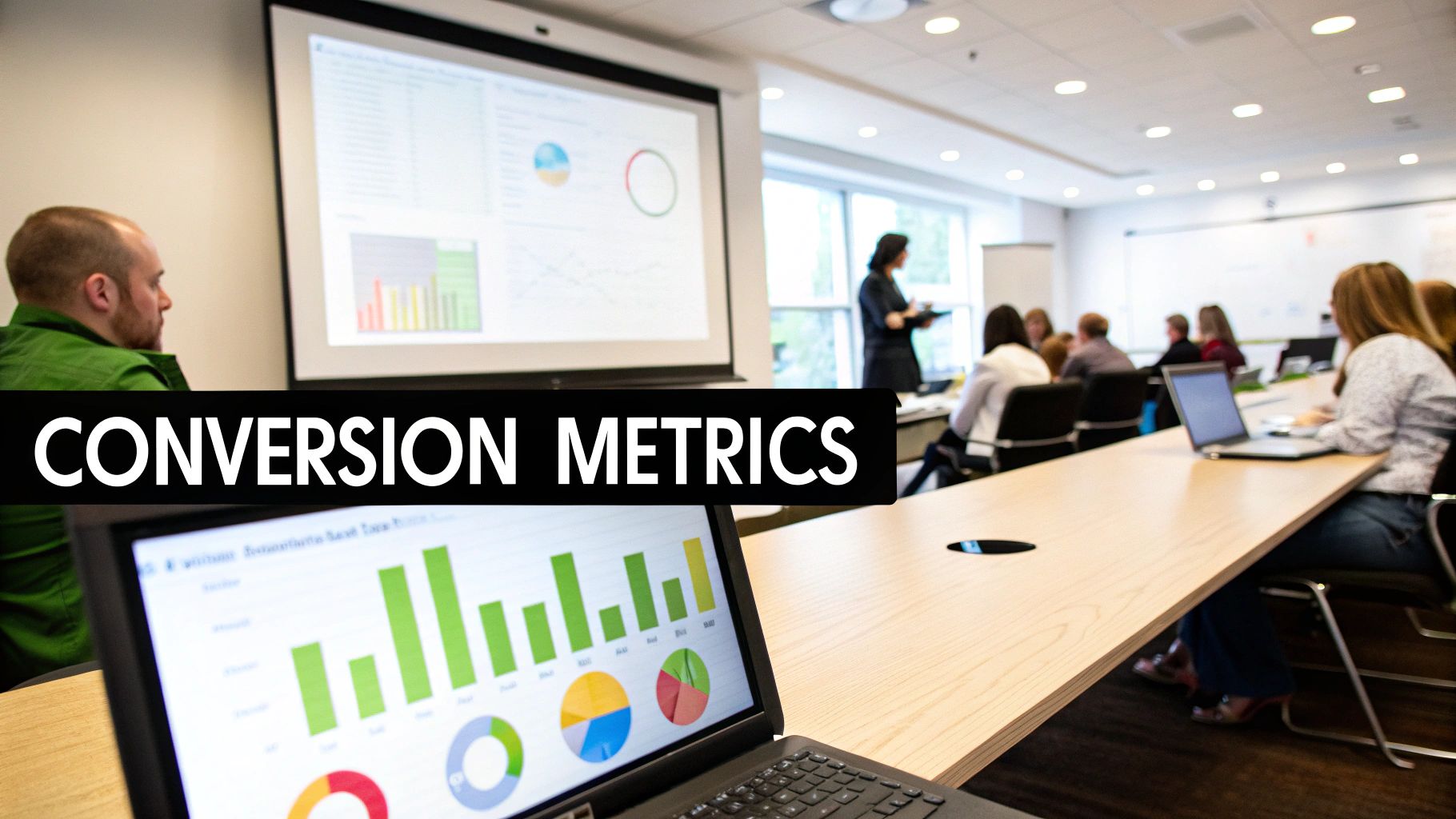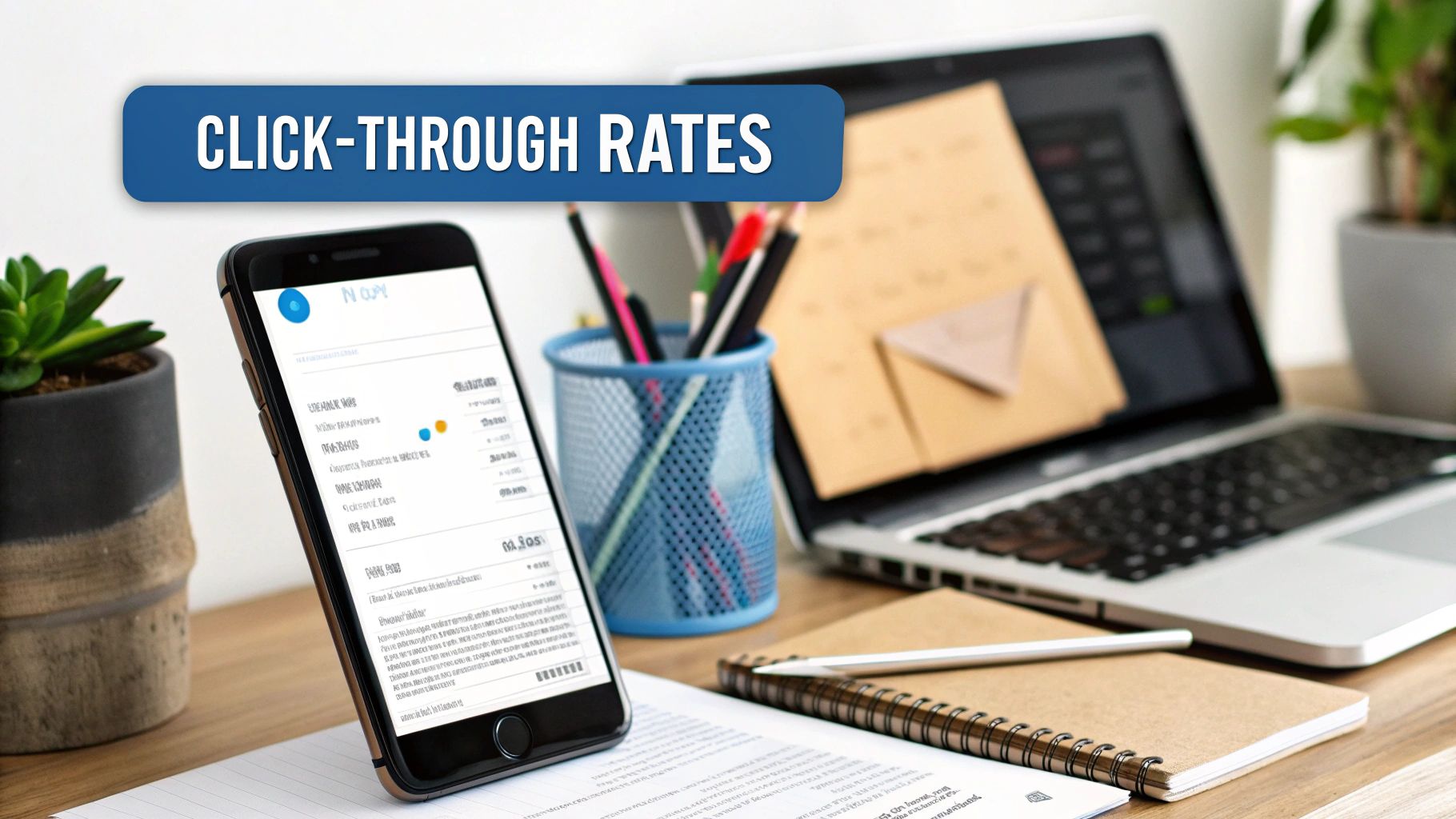Understanding Core Email Campaign Performance Metrics
Tracking email campaign metrics helps you understand what resonates with your audience and how to improve results. By analyzing key data points, you can make smarter decisions about your email strategy and create more engaging content that drives better outcomes.
Essential Metrics for Every Email Campaign
Start by looking at your open rate – the percentage of recipients who opened your email. This shows how well your subject lines and preview text grab attention. Next, check your click-through rate (CTR) to see how many people clicked links in your email. A strong CTR means your content connects with readers and motivates them to take action.
Pay close attention to email deliverability too. This shows what percentage of your emails actually reach inboxes. Aim for at least 99% deliverability – if it drops below 97%, you may have issues with spam filters or invalid addresses. To boost deliverability, verify your domain and avoid common spam triggers. Want to learn more? Check out these helpful resources: Email marketing metrics guide and Email deliverability best practices.
Delving Deeper with Advanced Metrics
For deeper insights, look at your click-to-open rate (CTOR). This compares clicks to opens to show how engaging your content is for people who read your emails. The higher your CTOR, the more compelling and clickable your content.
Track engagement time to see how long people spend with your emails. This reveals whether your content keeps readers' attention. While longer engagement often means higher interest, keep your messages focused and impactful.
Finally, measure subscriber lifetime value to identify your most valuable contacts. This helps you focus on building relationships with subscribers most likely to convert. You can then customize content for different subscriber segments based on their value and behavior.
By regularly checking these key metrics, you'll better understand what your audience wants and how to improve your email campaigns. Use the data to create content that connects, drives clicks, and turns subscribers into customers.
Measuring ROI and Financial Impact
Getting good open and click rates is important, but what really matters is the money your email campaigns bring in. Let's look at how to measure the financial results of your email marketing and show its value to your team and leadership.
Connecting Email Metrics to Revenue
The first challenge is linking email engagement to actual sales. This can be tricky since customers often take indirect paths to purchase. Someone might open your email on Monday, browse your site, leave without buying, then come back through Google on Friday to make a purchase. Good tracking tools help connect these dots so you can see how your emails drive real revenue.
Calculating Your Email Marketing ROI
Once you can trace revenue back to specific emails, calculating ROI becomes straightforward – just divide your profit by your costs. For example, if an email campaign brings in $10,000 in profit and costs $1,000 to create and send, that's a 1000% ROI. Email marketing consistently delivers amazing returns. Studies show businesses earn an average of $42 for every $1 spent – a 4,200% ROI. Some industries see even better results: retail hits 45:1, while marketing teams of 3-5 people average 42:1. Even email frequency matters – sending 9-16 emails monthly can achieve 46:1 ROI. Check out more stats here: Learn more about email marketing statistics.
Communicating ROI to Stakeholders
When sharing results with leadership, keep it simple and visual. Focus on the key numbers that show how emails impact revenue. Charts and graphs help tell the story quickly. Highlight both short-term campaign results and long-term ROI trends.
Improving Campaign Profitability
Beyond measuring results, work to make each campaign more profitable. Test different approaches, segment your audience for targeted messages, and analyze what works best. Use tools like EmailAddress.ai to maintain high deliverability and avoid wasting money on bad email addresses. Small improvements add up to significantly better ROI over time.
Advanced Engagement Metrics That Drive Results
Want to take your email campaigns beyond basic open and click rates? Let's explore some advanced metrics that reveal deeper insights into how subscribers engage with your emails and help predict future behaviors.
Click-to-Open Rate (CTOR)
The click-to-open rate (CTOR) measures how compelling your email content is for people who actually open it. Calculate it by dividing unique clicks by unique opens. A high CTOR means your content and calls-to-action resonate well with readers, while a low CTOR signals you may need to refresh your email design and messaging.
Engagement Time
Engagement time tracks how long subscribers spend interacting with your emails. Think of it as a measure of how captivated they are by your message. Longer engagement often indicates higher interest and better chances of conversion. But watch out – overly lengthy emails can cause readers to drop off. The key is finding the right balance between providing value and respecting their time.
Subscriber Lifetime Value (SLTV)
Looking at the bigger picture, subscriber lifetime value (SLTV) helps forecast how much revenue each subscriber may generate during their relationship with your brand. Use SLTV to identify your most valuable subscribers and create targeted campaigns just for them. This could include special offers, custom content, or early access to new products.
Implementing Advanced Tracking
Many modern email platforms make it easy to track these metrics through built-in analytics dashboards. EmailAddress.ai provides robust verification and analytics capabilities to ensure your data is accurate. Keep monitoring these key metrics consistently to spot trends and opportunities for improvement. Focus on steady progress rather than perfection – email marketing success comes from continuous testing and optimization.
Setting and Exceeding Industry Benchmarks
To know if your email campaigns are successful, you need to compare them against industry benchmarks. These benchmarks give you clear targets to aim for and help identify where you can improve. They're essential for setting realistic goals that push your campaigns forward.
Understanding Industry Differences
Email performance varies significantly between industries. B2C retail typically sees different open rates compared to B2B software companies, since customer behaviors and needs differ. When measuring your results, focus on benchmarks specific to your industry. The type of campaign also matters – promotional emails often get different engagement than newsletters. You might find this helpful: How to master your email sitemaps.
Key Performance Metrics
Several core metrics determine email campaign success:
- Open rates show if your subject lines catch attention
- Click-through rates measure content engagement
- Conversion rates track completed actions like purchases
- Deliverability indicates inbox placement success – aim for 99%
| Metric | Average | Good | Excellent |
|---|---|---|---|
| Open Rate | 15-25% | 25-35% | 35%+ |
| Click-Through Rate | 2-5% | 5-8% | 8%+ |
| Conversion Rate | 1-3% | 3-5% | 5%+ |
| Deliverability | 95% | 98% | 99%+ |
Note: These benchmarks are general guidelines and vary by industry.
Moving Past Industry Standards
The best email teams don't just meet benchmarks – they surpass them. Start by measuring your current metrics against industry averages. Then set specific, measurable goals with clear timeframes. For example, if you're at 20% opens and your industry averages 25%, target 30% within 3 months through better subject lines, content and segmentation.
Building Long-Term Success
Once you hit your targets, focus on maintaining momentum. Track metrics consistently, spot trends early, and adjust your approach as needed. Test new content formats, refine your targeting, and use tools like EmailAddress.ai for list verification. Regular analysis and experimentation help your campaigns stay effective. Make improvement a core part of your process, not just a one-time effort.
Implementing Data-Driven Optimization Strategies
Email marketing success requires ongoing monitoring and refinement based on performance data. By analyzing your metrics and making data-backed improvements, you can steadily enhance your results over time.
Building a Systematic Testing Program
A structured approach to testing helps pinpoint what resonates with your audience. A/B testing lets you compare different versions of email elements to see what performs better. For instance, testing two subject lines reveals which drives higher open rates. You can also experiment with send times to find when your audience is most engaged.
Identifying Meaningful Optimization Opportunities
Your testing data helps spotlight specific areas needing improvement. If you notice low click-through rates, your content may not connect with readers or your call-to-action might need work. When making changes, consider how optimizing one metric might affect others – for example, don't sacrifice click-throughs just to boost opens.
Prioritizing Changes Based on Potential Impact
Focus your optimization efforts where they'll have the biggest effect on your goals. For example, if you want more conversions, start by improving your call-to-action and landing page experience. Small conversion rate gains often impact revenue more than large open rate increases. Using EmailAddress.ai can help ensure good deliverability, which affects all other metrics.
Implementing Improvements and Measuring Effectiveness
After making changes, closely track your metrics to measure the impact. For example, when updating your email template design, monitor click-through and conversion rates in the following weeks. This cycle of testing, implementing, and measuring drives continuous improvement.
Building a Culture of Continuous Improvement
Make data-driven optimization an ongoing practice, not a one-time project. Have regular team meetings to review metrics, discuss insights, and brainstorm new test ideas. This collaborative approach keeps your email strategy evolving. Tools like EmailAddress.ai support this by providing reliable email validation data for your campaigns.
Future-Proofing Your Email Analytics Strategy
Email marketing continues to change with new technologies, tighter privacy rules, and evolving consumer preferences. To measure success effectively, marketers need to adapt quickly. Let's explore how to build a flexible approach that stands the test of time.
Adapting to Changing Privacy Regulations
Privacy laws like GDPR and CCPA now limit how we track email engagement. One major shift is Apple's Mail Privacy Protection, which makes open rate tracking less reliable. This means we need to focus on other metrics like clicks, conversions, and engagement to understand campaign performance.
Making the Most of New Technology
Modern email tools offer powerful ways to analyze campaigns. AI and machine learning help automate testing and personalization while providing deeper behavior insights. Better analytics dashboards now make it easier to spot trends through detailed data visualization. Understanding and using these capabilities gives marketers an edge.
Understanding Today's Consumer Habits
People now check email across multiple devices and have shorter attention spans. This makes mobile optimization and concise content crucial. Track metrics like engagement time and device usage to see how subscribers interact with your emails. For example, if most readers use mobile, prioritize mobile-friendly design. Knowing when interest drops helps optimize email length.
Building a Flexible Analytics Framework
Create an adaptable measurement system by:
- Using diverse metrics: Look beyond opens to get a complete view of performance
- Automating key tasks: Let AI handle repetitive work and uncover insights
- Putting users first: Design for different devices and preferences
- Staying up to date: Follow changes in privacy rules, tech, and user behavior
Steps to Update Your Measurement Approach
Get started with these actions:
- Review current metrics: Determine which measurements still matter and what to add or change
- Check out new tools: Look for platforms with AI insights and real-time data
- Run experiments: Test different email formats and content to see what works
- Keep learning: Help your team develop new skills and knowledge
Want better email deliverability and validation? Try EmailAddress.ai to verify your email lists with confidence.





